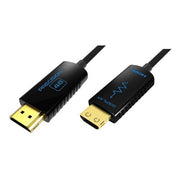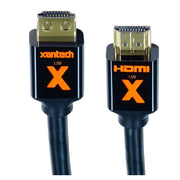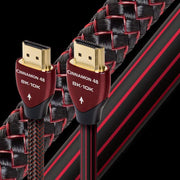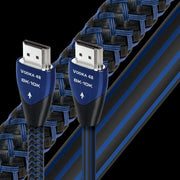When it comes to HDMI cables, the evolution has been a long pathway from 1.0 now to the 2.1a in a pace to keep up with the ever-growing quality of content we watch and the need to move large amounts of information quickly and accurately. The majority of HDMI cables are made of copper strands in varying qualities or composites, where fibre optic HDMI cables are made up of fibre strands and hybrid versions with copper also. Copper based cables currently max out at 48 gigabytes per second (in very short lengths), where fibre optical cables can theoretically reach 100s of terabytes per second which can simply provide an endless solution to the constantly evolving content demands and qualities.

Blustream PRECISION 48Gbps Fibre Optic HDMI Cable 8K AOC

1.5m Xantech EX Series High-speed HDMI Cable with X-GRIP

AudioQuest Cinnamon 48 Series HDMI Cable - 48Gbps

AudioQuest Vodka 48 Series HDMI Cable
So what is the difference?
Fibre strands are as thin as a human hair and information travels down the strands in the form of light, this means the information travels very close to the speed of light. Copper cables on the other hand, information travels as electrical current which is significantly slower.
The electrical signal in a copper cable creates a field of interference, electromagnetic interference, which has the potential to invade, cross talk and degrade the signal path. Fibre does not and is not susceptible to electromagnetic interference. This means essentially as a consumer, you will get a better quality product and return on investment by using a fibre cable as it is more secure and less likely to fault at the purpose it is made for.
The fact that fibre optic technology transfers the data as a light pulse, the HDMI cable needs to be able to convert the data from the source into light and back to a readable signal at the terminations of the cable. Fibre HDMI cables have a converter in each termination of the cable, this also lends to the one directional nature of the fibre optic cable, one end is designated for the source with the other end designated for the input device or display. This makes the HDMI cable an “active” connection requiring a little voltage to power the embedded electricity to light converters and the reverse. This is usually provided by the HDMI input of the display end of the cable but if this device is not outputting the correct voltage as per the HDMI spec this can be solved with a 5 volt HDMI to USB connector when the devices connected cannot supply the required voltage.
The most significant limitation of copper based cables is distance, fibre cables can easily reach distances of sixty metres with no loss at 4k@120hz / 8K@60Hz where you will require a certified 8K Ultra High Speed HDMI cable to pass these resolutions at a maximum of 5m.
Cable management and space can always be an issue when a system is setup with a variety of inputs outputs and sources. Fibre can simplify and enhance both of these factors by the simple fact at a minimum the strands are 25% smaller, more flexible and the variety of connections available for fibre HDMI cables is more flexible. This can benefit the system by increasing airflow to equipment, ease of changing and accessing cables, and be aesthetically better than the copper counterparts.
So the benefits are there. The cost is a key point to consider and the details of fibre cables should also be clear when purchasing. Firstly fibre optic HDMI are single direction, they also may require a specific voltage output from the source to the receiving equipment to function correctly. In terms of the use, speeds of connection may increase between devices and with the advent of 8k, 10k and more, cables with greater than 48gbs bandwidth will quite likely be necessary. Fibre optic HDMI cables offer more efficient solutions, better return on investment and a future proof way to ensure your media is transmitted without fault and maintained quality.







